Sharing the road
Sharing the road with smaller vehicles
Be aware that most drivers of smaller vehicles do not understand what it is like to drive a large vehicle such as a tractor-trailer. Many do not realize that a tractor-trailer needs twice as much stopping distance as the average car, and takes much longer to get up to normal driving speed. Many drivers also feel nervous when a large vehicle comes up behind or beside them, and this may cause them to make sudden or unexpected moves.
Here are some tips for sharing the road with smaller vehicles:
- Following: It is very dangerous to follow too closely behind another vehicle. If something unexpected occurs, you will not have enough room to stop safely. Also, be aware that a large vehicle looming up closely behind may intimidate drivers of small vehicles.
- Being passed: Be courteous when smaller, faster vehicles are trying to pass you. Slow down enough to allow the vehicle to fit in quickly and safely in front of you.
- Signalling: Signal your intentions clearly before turning, slowing or stopping so that other drivers will have adequate time to react appropriately.
- Turning: Many drivers of smaller vehicles do not understand how much room large vehicles need in order to make a turn. Drivers of smaller vehicles will often drive up into the large vehicle’s turning space, not realizing until too late that the large vehicle needs that space to complete the turn. To safely complete a turn, you should proceed slowly and observe the rear of the vehicle. Always check to make sure a vehicle has not moved up into your turning space before completing your turn.
Sharing the road with motorcycles, limited-speed motorcycles or mopeds
Motorcycles, limited-speed motorcycles and mopeds are harder to see because of their size. Drivers of these vehicles may make sudden moves because of uneven road surfaces or poor weather conditions. Because they are less protected, they are more likely to be injured in a collision.
Motorcycles and mopeds that cannot keep up with traffic should drive as close as possible to the right edge of the road; however, remember that these vehicles have the right to use the whole lane.
Since many motorcycle turn signals do not automatically shut off, be careful when turning left in front of an oncoming motorcycle with its turn signal on. Make sure the motorcyclist is actually turning; he or she may have just forgotten to switch off the turn signal.
Sharing the road with cyclists
Bicycles and mopeds travelling at a lower speed than other traffic are expected to ride about one metre from the curb or parked cars, or as close as practical to the right-hand edge of the road when there is no curb. However, they can use any part of the lane if necessary for safety, such as to:
- avoid obstacles such as puddles, ice, sand, debris, rutted or grooved pavement, potholes and sewer grates
- cross railway or streetcar tracks at a 90° angle
- discourage passing where the lane is too narrow to be shared safely
Cyclists are not required to ride close to the right edge of the road when they are travelling at or faster than the normal speed of traffic at that time and place, or when they are turning left, or getting in position to turn left. (Cyclists are permitted to make a left turn from a left-turn lane, where one is available.)
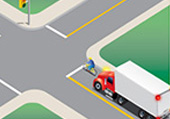
When passing a cyclist, as a best practice, allow at least one metre between your vehicle and the cyclist. Whenever possible, you should change lanes to pass.
Do not follow too closely behind cyclists. They do not have brake lights to warn you when they are slowing or stopping. Intersections – To avoid collisions with bicyclists at intersections, remember the following:
- When turning right, signal and check your mirrors and the blind spot to your right to make sure you do not cut off a cyclist.
- When turning left, you must stop and wait for oncoming bicycles to pass before turning.
- When driving through an intersection, be careful to scan for cyclists waiting to turn left.
Do not sound your horn unnecessarily when you are overtaking a cyclist. It may frighten them and cause them to lose control. If you feel that you must use your horn, tap it quickly and lightly while you are still some distance away from the cyclist.
Bike lanes are reserved for cyclists. They are typically marked by a solid white line. Sometimes you will need to enter or cross a bike lane to turn right at a corner or driveway. Take extra care when you do this. Enter the bike lane only after ensuring that you can do so safely, and then make the turn.
Watch for cyclists’ hand signals. A cyclist may indicate a right-hand turn by extending their right arm.
Try to make eye contact when possible with cyclists.
Bike boxes help prevent collisions between motorists and bicycles at intersections. It is typically a painted box on the road with a white bicycle symbol inside. Bicycle lanes approaching and leaving the box may also be painted. As a driver, you must stop for a traffic signal behind the bike box. Do not stop in the box.
Children riding bicycles on the street may lack the necessary training and skills for safe cycling. They may not be aware of all the dangers or the rules of the road. Watch for children on oversized bicycles as they may not have the ability to control it.
When parked on the side of the roadway, look behind you and check your mirrors and blind spots for a passing cyclist before opening a door.

Sharing the road with municipal buses
Many roadways have special indented stopping areas for municipal buses, called bus bays, where passengers can get on and off. There are three types of bus bays:
- mid-block indented bays
- indentations immediately before and after intersections
- bus-stop areas between two designated parking areas
When a bus in a bus bay begins flashing its left-turn signals, indicating that it is ready to leave the bus bay, and you are approaching in the lane adjacent to the bus bay, you must allow the bus to re-enter traffic.
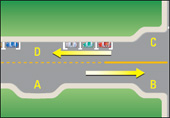
A: Mid-block indented bays
B: An indentation before an intersection
C: An indentation after an intersection
D: Bus stops between legally parked cars
Sharing the road with farm machinery
Farm machinery moves quite slowly compared to other road users. Most tractors and combines have a maximum speed of 40 km/h, but travel at less than 40 km/h when towing implements or wagons. Farm machinery is often oversized, wide or long or both, making it difficult for the driver to see vehicles coming up from behind. Farmers often turn directly into fields rather than roads or lanes, or move from lane to lane. Remember that it is common for farmers to be on the roads after dark during peak planting and harvesting seasons. Farm machinery on the road must display an orange and red slow-moving vehicle sign on the rear of the vehicle. The sign warns other drivers that the vehicle is travelling at 40 km/h or less. If you see one of these signs, slow down and be cautious. Stay well back and do not pass until it is safe to do so.
Sharing the road with pedestrians
Pay special attention to pedestrians, whether they are crossing roads in traffic, walking or jogging alongside roads, or using crosswalks or crossovers (generally known as crossings). Drivers should be aware of pedestrians who often will jaywalk not just cross at intersections. Note that a ball bouncing into the roadway may be followed by a child or animal. Watch for children. Drive slowly and cautiously through school zones, residential areas and any other area where children may be walking or playing. You never know when a child might dart out from between parked cars or try to cross a street without checking for oncoming traffic. Be very cautious at twilight when children may still be playing outside, but are very difficult to see. Watch out for Community Safety Zone signs as they indicate areas where the community has identified that there is a special risk to pedestrians.
Seniors or pedestrains with disabilities need extra caution and courtesy from drivers, as they may be slow in crossing the road. Be alert for pedestrians with visual or hearing disabilities, those who use wheelchairs or walk slowly due to some other physical disabilities, and give them appropriate consideration. Pedestrians who are blind or with a visual disability may use a white cane or guide dog to help them travel safely along sidewalks and across intersections. Caution signs are posted in some areas where there is a special need for drivers to be alert.
Persons operating mobility devices (motorized wheelchair and medical scooters) are treated the same way as pedestrians. Usually these people will travel along a sidewalk, but if there is no sidewalk available, they should travel, like pedestrians, along the left shoulder of the roadway facing oncoming traffic.
Some streetcar stops have a special safety island or zone for passengers getting on and off. Pass these safety islands and zones at a reasonable speed. Always be ready in case pedestrians make sudden or unexpected moves.
Yielding the right-of-way
There are times when you must yield the right-of-way. This means you must let another person go first. Here are some rules about when you must yield the right-of-way:
At an intersection without signs or lights, you must yield the right- of-way to any vehicle approaching from the right (Diagram 3-4).

At an intersection with stop signs at all corners, you must yield the right-of-way to the first vehicle to come to a complete stop. If two vehicles stop at the same time, the vehicle on the left must yield to the vehicle on the right (Diagram 3-5).
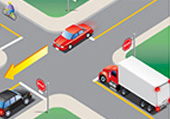
At any intersection where you want to turn left or right, you must yield the right-of-way. If you are turning left, you must wait for approaching traffic to pass or turn and for pedestrians in your path to cross. If you are turning right, you must wait for pedestrians to cross (Diagram 3-6).
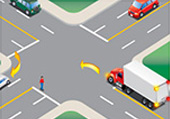
A yield sign means you must slow down or stop if necessary and yield the right-of-way to traffic in the intersection or on the intersecting road. When entering a road from a private road or driveway, you must yield to vehicles on the road and pedestrians on the sidewalk (Diagram 3-7).
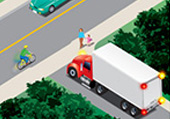
You must yield the right-of-way and wait for pedestrians to completely cross the road at specially marked pedestrian crossings or crossovers (Diagram 3-8), as well as school crossings with crossing guards.
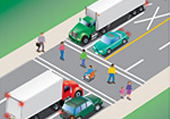
Remember: Signalling does not give you the right-of-way. You must make sure the way is clear.
Driving in roundabouts
Allow extra room alongside large vehicles (trucks and buses). They may have to swing wide on the approach or within the roundabout. Give them plenty of room.
Pull over for emergency vehicles
If you are in a roundabout when an emergency vehicle approaches, continue to your intended exit and proceed beyond the traffic island before pulling over. If you have not entered the roundabout yet, pull over to the right if possible and wait until the emergency vehicle has passed.
Driving a large vehicle in a roundabout
A driver negotiating a roundabout in a large vehicle (such as a truck or bus) may need to use the full width of the roadway, including the central apron (a mountable portion of the centre island adjacent to the roadway) if provided. Prior to entering the roundabout, the vehicle may need to occupy both lanes. Give large vehicles plenty of room to manoeuvre.
Many roundabouts are also designed with a central apron, a raised section of pavement around the central island that acts as an extra lane for large vehicles. The back wheels of the oversize vehicle can ride up on the central apron so the truck can easily complete the turn, while the raised portion of concrete discourages use by smaller vehicles.

10 ways you can help make Ontario's roads the safest in North America
- Don't drink and drive. Don't drive when you're taking medication that will affect your driving
- Always wear your seat belt
- Obey the speed limits. Slow down when road and weather conditions are poor
- Don't take risks: don't cut people off in traffic, make sudden lane changes or run yellow lights
- Don't drive when you're tired, upset or sick
- If you're in doubt, let the other driver go first — yield the right-of-way
- Keep a safe distance between your vehicle and the one ahead
- Avoid distractions such as loud music and cell phones
- Check your mirrors frequently; always check your blind spot before you change lanes
- Check traffic in all directions before going into an intersection